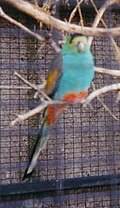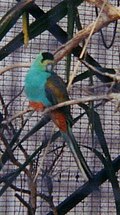Difference between revisions of "AY Honors/Parrots and Cockatoos/Answer Key"
| (12 intermediate revisions by the same user not shown) | |||
| Line 1: | Line 1: | ||
{{Taxobox | {{Taxobox | ||
| − | | | + | | image = Golden-Shouldered-Parrot-3.jpg |
| − | | | + | | name = Golden-shouldered Parrot |
| − | | | + | | status = EN |
| − | | | + | | trend = down |
| regnum = [[Animal]]ia | | regnum = [[Animal]]ia | ||
| − | | phylum = [[Chordata]] | + | | phylum = [[Chordate|Chordata]] |
| classis = [[Aves]] | | classis = [[Aves]] | ||
| ordo = [[Psittaciformes]] | | ordo = [[Psittaciformes]] | ||
| − | | familia = [[ | + | | familia = [[Psittacidae]] |
| − | | subfamilia = | + | | subfamilia = [[Platycercinae]] |
| − | | genus = '' | + | | tribus = [[Platycercini]] |
| − | + | | genus = ''[[Psephotus]]'' | |
| − | | species = '''''P. | + | | species = '''''P. chrysopterygius''''' |
| − | | binomial = '' | + | | binomial = ''Psephotus chrysopterygius'' |
| − | | binomial_authority = [[ | + | | binomial_authority = [[John Gould|Gould]], 1858 |
| − | |||
| − | |||
| − | |||
| − | |||
| − | |||
| − | |||
| − | |||
| − | |||
}} | }} | ||
| − | The ''' | + | The '''Golden-shouldered Parrot''' (''Psephotus chrysopterygius'') is a rare [[Aves|bird]] of southern [[Cape York Peninsula]], in [[Queensland]], [[Australia]]. A small attractive [[parrot]] related to the more common [[Red-rumped Parrot]], it is considered to be a [[superspecies]] with the [[Hooded Parrot]] ''(P. dissimilis)'' of the [[Northern Territory]] and the apparently [[Extinction|extinct]] [[Paradise Parrot]] of [[Queensland]] and [[New South Wales]]. It measures 26 cm long and weighs between 54-56 g. |
| − | The | + | The Golden-shouldered Parrot lives in open forest, where it feeds on small grass [[seed]]s, principally those of [[firegrass]]. An important [[habitat (ecology)|habitat]] requirement is the provision of terrestrial [[Termite|termite mounds]], which the bird uses for nesting in. This has led to the parrot also being known as the Antbed Parrot. They will preferentially seek out taller mounds (up to 2 m high), and will dig a burrow into them when the mound has been softened by the rains. A long tunnel is dug down into the mound, and capped off by a nesting chamber. The clutch size is between 3-6 [[Egg (biology)|egg]]s, which are [[incubate]]d for 20 days. The mound regulates the temperature in the chamber, keeping it high enough that the eggs can be left unattended while the parents feed. |
| − | The | + | The Golden-shouldered Parrot is listed as [[Endangered species|endangered]] ([[CITES]] I). The species has a restricted range and suffers from a variety of threats, including predation by [[feral cat]]s, [[tourist]] disturbance, and a change in burning regime in the grasslands upon whose seeds it depends. The wild population is around 3000 birds, with around 1500 held in captivity in Australia. |
| − | + | == References == | |
| + | * {{IUCN2006|assessors=BirdLife International|year=2006|id=18423|title=Psephotus chrysopterygius|downloaded=11 May 2006}} Database entry includes justification for why this species is endangered | ||
| + | ''Handbook of the Birds of the World, Vol 4'' Edited by del Hoyo, Elliott and Sargatal ISBN 84-87334-22-9 | ||
| + | why is it endangered | ||
| − | == | + | == Photos == |
<gallery> | <gallery> | ||
| − | Image: | + | Image:Golden-Shouldered-Parrot-1.JPG|Male Golden-shouldered Parrot in an aviary at the [[Queensland Museum]] (photo taken during 2004) |
| + | Image:Golden-Shouldered-Parrot-2.JPG|Male Golden-shouldered Parrot in an aviary at the [[Queensland Museum]] (photo taken during 2004) | ||
| + | </gallery> | ||
| + | <gallery> | ||
| + | Image:Golden-Shouldered-Parrots-1.JPG|Male and female Golden-shouldered Parrots in an aviary at the [[Queensland Museum]] (photo taken during 2004) | ||
| + | Image:Golden-Shouldered-Parrots-2.JPG|Male and female Golden-shouldered Parrots in an aviary at the [[Queensland Museum]] (photo taken during 2004) | ||
</gallery> | </gallery> | ||
| − | |||
| − | |||
| − | |||
| − | |||
| − | |||
| − | |||
== External links == | == External links == | ||
| − | * [http://www. | + | * [http://www.arkive.org/species/GES/birds/Psephotus_chrysopterygius/ Golden-shouldered parrot — photos and information] |
| − | * [http://www. | + | * [http://www.birdlife.org/datazone/search/species_search.html?action=SpcHTMDetails.asp&sid=1473&m=0 Golden-shouldered parrot — BirdLife Species Factsheet] |
| − | |||
| − | |||
| − | |||
| − | |||
| − | |||
| − | |||
| − | |||
[[Category:Birds of Australia]] | [[Category:Birds of Australia]] | ||
| − | [[Category: | + | [[Category:Broad-tailed parrots]] |
| − | [[Category: | + | [[Category:Psephotus]] |
| − | [[Category: | + | [[Category:Endangered species]] |
| − | [[Category: | + | [[Category:Australian restricted-range endemic bird species]] |
| + | [[Category:Endangered fauna of Australia]] | ||
| − | + | [[fr:Psephotus chrysopterygius]] | |
| − | + | [[hu:Aranyosvállú papagáj]] | |
| − | + | [[ru:Златоплечий певчий попугай]] | |
| − | [[fr: | ||
| − | |||
| − | |||
| − | |||
| − | [[hu: | ||
| − | |||
| − | [[ru: | ||
| − | |||
| − | |||
| − | |||
| − | |||
Revision as of 08:53, 5 May 2008
The Golden-shouldered Parrot (Psephotus chrysopterygius) is a rare bird of southern Cape York Peninsula, in Queensland, Australia. A small attractive parrot related to the more common Red-rumped Parrot, it is considered to be a superspecies with the Hooded Parrot (P. dissimilis) of the Northern Territory and the apparently extinct Paradise Parrot of Queensland and New South Wales. It measures 26 cm long and weighs between 54-56 g.
The Golden-shouldered Parrot lives in open forest, where it feeds on small grass seeds, principally those of firegrass. An important habitat requirement is the provision of terrestrial termite mounds, which the bird uses for nesting in. This has led to the parrot also being known as the Antbed Parrot. They will preferentially seek out taller mounds (up to 2 m high), and will dig a burrow into them when the mound has been softened by the rains. A long tunnel is dug down into the mound, and capped off by a nesting chamber. The clutch size is between 3-6 eggs, which are incubated for 20 days. The mound regulates the temperature in the chamber, keeping it high enough that the eggs can be left unattended while the parents feed.
The Golden-shouldered Parrot is listed as endangered (CITES I). The species has a restricted range and suffers from a variety of threats, including predation by feral cats, tourist disturbance, and a change in burning regime in the grasslands upon whose seeds it depends. The wild population is around 3000 birds, with around 1500 held in captivity in Australia.
References
- Template:IUCN2006 Database entry includes justification for why this species is endangered
Handbook of the Birds of the World, Vol 4 Edited by del Hoyo, Elliott and Sargatal ISBN 84-87334-22-9 why is it endangered
Photos
Male Golden-shouldered Parrot in an aviary at the Queensland Museum (photo taken during 2004)
Male Golden-shouldered Parrot in an aviary at the Queensland Museum (photo taken during 2004)
Male and female Golden-shouldered Parrots in an aviary at the Queensland Museum (photo taken during 2004)
- Golden-Shouldered-Parrots-2.JPG
Male and female Golden-shouldered Parrots in an aviary at the Queensland Museum (photo taken during 2004)
External links
- Golden-shouldered parrot — photos and information
- Golden-shouldered parrot — BirdLife Species Factsheet
fr:Psephotus chrysopterygius hu:Aranyosvállú papagáj ru:Златоплечий певчий попугай



